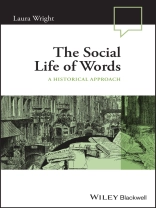A new approach to sociolinguistics, introducing the study of the social meaning of English words over time, and offering an engaging and entertaining demonstration of lexical sociolinguistic analysis
The Social Life of Words: A Historical Approach explores the rise and fall of the social properties of words, charting ways in which they take on new social connotations. Written in an engaging narrative style, this entertaining text matches up sociolinguistic theory with social history and biography to discover which kind of people used what kind of word, where and when. Social factors such as class, age, race, region, gender, occupation, religion and criminality are discussed in British and American English.
From familiar words such as popcorn, porridge, café, to less common words like burgoo, califont, etna, and phrases like kiss me quick, monkey parade, slap-bang shop, The Social Life of Words demonstrates some of the many ways a new word or phrase can develop social affiliations. Detailed yet accessible chapters cover key areas of historical sociolinguistics, including concepts such as social networks, communities of practice, indexicality and enregisterment, prototypes and stereotypes, polysemy, onomasiology, language regard, lexical appropriation, and more. The first book to take a focused look at lexis as a topic for sociolinguistic analysis, The Social Life of Words:
* Introduces sociolinguistic theories and shows how they can be applied to the lexicon
* Demonstrates how readers can apply sociolinguistic theory to their own analyses of words in English and other languages
* Provides an engaging and amusing new look at many familiar words, inviting students to explore the sociolinguistic properties of words over time for themselves
Part of Wiley Blackwell’s acclaimed Language in Society series, The Social Life of Words is essential reading for upper-level undergraduate students, graduate students, postdoctoral researchers, and linguists working in sociolinguistics, lexical semantics, English lexicology, and the history and development of modern English.
İçerik tablosu
Series Editor’s Preface x
Acknowledgements xi
I Introduction: geyser, califont, ascot 1
I.1 On Concepts, Approaches, Methods, and Theories 4
I.2 On Sources 9
I.3 Editorial Principles 11
1 Lexical Sociolinguistics and Social Networks 15
1.1 Introduction to Social Network Theory 15
1.2 Previous Scholarship 16
1.3 Swiss waiter 17
1.4 Sosison Vo Land 26
1.5 Summary 29
2 Lexical Sociolinguistics and Communities of Practice 31
2.1 Introduction to Communities of Practice 31
2.2 Previous Scholarship 32
2.3 Etna 33
2.3.1 Summary 41
2.4 Laugh! 42
2.5 Summary 45
3 The Sociolinguistics of Polysemy 47
3.1 Introduction to the Sociolinguistics of Polysemy 47
3.2 Previous Scholarship 47
3.3 Maroon 49
3.4 Popcorn 55
3.5 Summary 63
4 The Sociolinguistics of Onomasiology 65
4.1 Introduction to the Sociolinguistics of Onomasiology 65
4.2 Previous Scholarship 65
4.3 direction, address 68
4.4 Kiss Me Quick 74
4.5 Summary 77
5 The Sociolinguistics of Stereotypes 79
5.1 Introduction to the Sociolinguistics of Stereotypes 79
5.2 Previous Scholarship 80
5.3 Goss 81
5.4 Goodwill 83
5.5 Porridge 84
5.6 Fido, Rover 95
5.7 Summary 99
6 Language Regard and Lexical Influencers 102
6.1 Introduction to Language Regard 102
6.2 Previous Scholarship 102
6.3 Café, Restaurant 103
6.3.1 Restaurant 104
6.3.2 Café 106
6.3.3 Slap-Bang Shop 107
6.3.4 Ordinary 108
6.3.5 Alamode Beefshop 109
6.3.6 Coffee-House 111
6.3.7 Coffee-Palace and Coffee-Tavern 112
6.3.8 Buffet 113
6.3.9 Time-Line of Development 114
6.3.10 Coffee Shop 118
6.4 Summary 119
7 Lexical Sociolinguistics, Indexicality and Enregisterment 121
7.1 Introduction to Indexicality and Enregisterment 121
7.2 Previous Scholarship 122
7.3 Drage 124
7.4 Tinned Salmon 127
7.5 Rather! 132
7.6 Summary 134
8 Lexical Sociolinguistics and Spatial Spread 137
8.1 Introduction to Spatial Spread 137
8.2 Previous Scholarship 138
8.3 Monkey Parade, Shopping Parade 140
8.3.1 Summary 146
8.4 Sunnyside 146
8.5 Summary 149
9 Lexical Appropriation 151
9.1 Introduction to Lexical Appropriation 151
9.2 Into 152
9.3 Baggonet 156
9.4 Burgoo 162
9.4.1 What Is Already Known About burgoo 165
9.4.2 Further Data Assembled in Date Order 165
9.4.3 Polysemous Senses of burgoo 167
9.4.4 Onomasiological Sets 168
9.4.5 Spread of burgoo in Physical Space 168
9.4.6 Spread of burgoo in Social Space 172
9.4.7 Perceived Space and Authority Constraints 172
9.4.8 Evidence of Indexicality and Enregisterment 176
9.4.9 Stereotypical Properties 176
9.4.10 Language Regard and Lexical Appropriation 177
9.5 Summary 178
10 Future Directions 181
References 192
Index 195
Yazar hakkında
Laura Wright is a Professor of English Language at the University of Cambridge. She is a historical sociolinguist who tracks the social history of English. Her books include Sunnyside: A Sociolinguistic History of British House Names, The Multilingual Origins of Standard English, Southern English Varieties Then and Now, and Multilingual Practices in Language History: New Perspectives.












